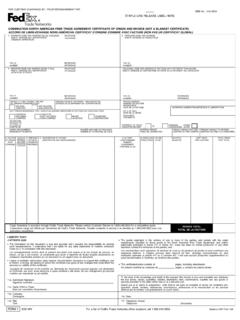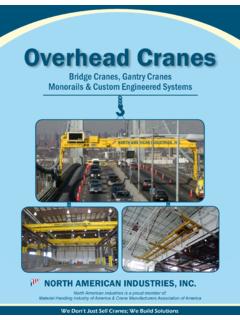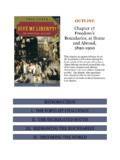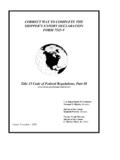Transcription of Migration, Trade, and Foreign Direct Investment in …
1 Migration, trade , and Foreign DirectInvestment in MexicoPatricio Aroca and William F. MaloneyPart of the rationale for the north american free trade Agreement was that it wouldincrease trade and Foreign Direct Investment (FDI) flows, creating jobs and reducingmigration to the United States. Since poor data on illegal migration to the United Statesmake Direct measurement difficult, data on migration within Mexico, where censusdata permit careful analysis, are used instead to evaluate the mechanism behindpredictions on migration to the United States. Specifications are provided for migrationwithin Mexico, incorporating measures of cost of living, amenities, and to much of the literature, labor market variables enter very significantlyand as predicted once possible credit constraint effects are controlled for. Greaterexposure toFDIand trade deters outmigration, with the effects working partly throughthe labor market.
2 Finally, some tentative inferences are presented about the impact ofincreasedFDIon Mexico migration. On average, a doubling ofFDIinflows leads toa 2 percent drop in migration. Mexico wants to export goods, not people. Former Mexican President Carlos Salinas de GortariMexican President Carlos Salinas de Gortari promoted the north AmericanFree trade Agreement (NAFTA) partly on the grounds that it would reduceincentives for Mexicans to migrate north . While this rationale is intuitivelyappealing, several studies have suggested possible slips twixt cup and lip. Razin and Sadka (1997) note that dropping the assumption of identicalproduction technologies or permitting increasing returns to scale allows tradeand migration to be complements rather than andZahniser (1999), drawing on models and empirical evidence by Feenstra andPatricio Aroca is a professor and director of the Institute for Applied Regional Economy (IDEAR), at theUniversidadCato economist in the Office of the Chief Economist for Latin America at the World Bank; his email address The research for this article was financed by the regional studies program of theOffice of the Chief Economist for Latin America at the World Bank.
3 The authors thank Jaime de Melo,Gordon Hanson, andRaymond Robertsonfor insightful commentsandGabriel Montes Rojasand LucasSigafor expert research More generally, Faini (2004) notes the complex feedback among Trade, FDI, and migration that canobscure the final impact on migration of liberalizing one sector. See also Faini, Grether, and De Melo (1999).THE WORLD BANK ECONOMIC REVIEW, , , pp. 449 472 Access publication December 14, 2005 The Author 2005. Published by Oxford University Press on behalf of the InternationalBank for Reconstruction and Development /THE WORLD BANK. All rights reserved. For permissions,please e-mail: (1995) and Markusen and Venables (1997), suggest that the foreigndirect Investment (FDI) and trade effects of NAFTA are likely to increase therelative earnings of skilled workers but not those of unskilled workers, who aremost likely to migrate. Much of the migration literature has failed to find asignificant impact on migration of wages or unemployment rates in the initiallocation (Greenwood 1997; Lucas 1997), casting some doubt on the strength ofany trade orFDIeffects working through the home country labor most worrisome, there is increasing evidence that liquidity constraintsare a barrier to migration it takes resources to move (Stark and Taylor 1991).
4 IfFDIor trade flows relax this constraint, however, the expected substitutioneffect may be partially or completely offset, leading to more migration (Lo pezand Schiff 1998).The illicit nature of Mexican migration flows means that they are poorlymeasured. Thus, indirect approaches are needed. A small detailed case studyliterature on individual municipalities offers some suggestive evidence thatNAFTA-related phenomena female manufacturing employment and proximityto amaquila might reduce a times-series context, Hansonand Spilimbergo (1999) find that border apprehensions are responsive to Mexico wage differentials, a finding confirmed by McKenzie and Rapoport(2004) using a retrospective survey. Davila and Saenz (1990) find a negativerelationship between laggedmaquilaemployment on the border and monthlyborder apprehensions as a proxy for migration pressures. Unfortunately, moredirect data onFDIand trade with adequate periodicity or span are unavailable tooffer enough degrees of freedom to permit inference with any confidence.
5 Further,the massive peso crisis beginning roughly with the signing of NAFTA led to asharp spike in unemployment and a 25 percent drop in wages. These likelyinduced migration flows to the United States that complicate inference on themore modest effects that NAFTA might have had in the opposite these reasons, this article focuses on the mechanisms through whichNAFTA-related variables might work, using data on migration flows withinMexico, across its 32 states. The 2000 census data permit careful analysis, andthe 32 by 32 permutations offer substantial degrees of casual look at maps showing rates of net migration (net flows as a share ofthe population in the initial period) by state (figure 1) andFDIby state (figure 2)suggests a relationship between the magnitude ofFDIand migration. By morerigorously investigating this possibility forFDIand other trade variables, thisarticle makes three contributions to the literature on migration generally and,more specifically, on the impact of trade andFDIflows on Using data gathered in 25 Mexican communities, Massey and Espinosa (1997) create histories ofmigrants to the United States and find initial migration to be negatively related to the wage rate and theproportion of women in manufacturing.
6 Jones (2001) examines 17 emigrant municipalities and argues foran association between proximity tomaquiladorasand employment growth and, in turn, decliningmigration to the United WORLD BANK ECONOMIC REVIEW, , , the analysis produces the first estimates of determinants of migrationflows within Mexico and advances the literature on developing country line with recent innovations in the literature on industrial countries, the analysisgenerates proxies for the level of amenities and costs of living and finds theirinfluence to be statistically significant. Further, contrary to much of the literatureFIGURE1. Net Migration in Mexican States, 2000 Source:General Census of Population and Housing Foreign Direct Investment per Capita by Mexican States, 1994 2000 Source:Central Bank of and Maloney451for both industrial and developing countries noted above, the specification appliedhere allows disentangling the relative expected earnings effect from the liquidityeffect.
7 The results are highly significant, with intuitively plausible signs on labormarket variables. Finally, network effects are introduced and also found to bestrongly , the article offers evidence that bothFDIand trade variables are sub-stitutes for labor flows, are likely to work through the labor market, and havesubstantial deterrent effects. Even without the application to internationalmigration, this finding is of intrinsic interest for the literature exploring thenexus of national spatial income disparities and migration (Barro and Sala-Martin1992; Gabriel, Shack-Marquez, and Wascher 1993; Esquivel 1997) and theliterature on how trade liberalization may affect regional disparities (Hanson1997; Aroca, Bosch, and Maloney forthcoming). However, by establishing thatthe mechanisms through which NAFTA was expected to affect migration indeedfunction at the domestic level, the article supports President Salinas s claim forinternational migration as well.
8 Further, the analysis implicitly addressesMarkusen and Zahniser s (1999) concern that the skills demanded byFDIandtrade are higher than those possessed by the majority of migrants to the UnitedStates and hence that NAFTA may have no effect. Finally, the results are alsoconsistent with Robertson s (forthcoming) that trade is a force for wageconvergence between the United States and Mexico more , the article offers some tentative back of the envelope inferences aboutthe impact on Mexico migration, implicitly treating the United States as the33rd Mexican state. The magnitude of the impacts are found to be METHODOLOGYA potential migrant facesjpossible destinations, whereiis the region of originandkis the migration region chosen, so that a worker s internal migrationdecision is reflected by the sign of the index function:I Vk Vi C: 1 whereVis an indirect utility function in the context of random utility theory(Domencich and McFadden 1975; Train 1986) andCis a measure of is a function of a linear combination of location Xj "j: 2 If a migration destination is more desirable than the origin location, measured alongseveral dimensions, and if the migrant has sufficient resources to move, then migra-tion should occur.
9 The probability that the indicator will be larger than zero is equalto the probability that the difference betweenVs is greater than transport costs:P I >0 P Vk Vt C>0 P "i "k Xk Xi C : 3 452 THE WORLD BANK ECONOMIC REVIEW, , specification nests many standard estimated functions (Greenwood 1997)including Borjas (1994, 2001), where the only argument in the utility function isthe may be allowed to vary, and in fact the literature tends to find agreater role for destination variables than for origin variables. This may bebecause of asymmetric information about locations (Gabriel, Shack-Marquez,and Wascher 1993) or because the individual variables are correlated withomitted variables that may have a greater impact on one end of the migrationmove. As discussed in more detail later, many variables could be correlated withunmeasured wealth or liquidity, which would determine whether the workerhas the savings to pay the fixed cost of moving, matrixXcontains the variables capturing the relative expected incomes,Y, in the two areas (wages, unemployment, and price indices) and the set ofcharacteristics of the two areas (amenities) that may also affect the migrationdecision.
10 Any impact ofFDIand trade would be expected to occur Ben-Akiva and Lerman (1985), as generalized in Gourieroux(2000), for aggregate data:F 1 P I >0 Xk d Xi o C: 4 whereFis the probability function that is determined by the structure of overall approach is to estimate a broadly standard specification augmen-ted by some additional proxies and modified to better capture liquidity variables are then introduced to explore the degree to whichtheir effects are channeled through the labor DATAData were collected on migration specifications and on trade and investmentflows. Data sources and shortcomings are described in the following of the variables is ideal, but they are complementary in the sense of somebeing strong where others are weak. Together, this may provide a reliablepicture of the impact of trade and Investment SpecificationsData were collected on interstate migration flows, moving costs, networks,population by state, labor markets, cost of living, and Borjas (2001) argues thatI* maxjfwjg wi C, whereI*is an indicator variable,wis the wage,andCis the cost of transportation to the new location.















